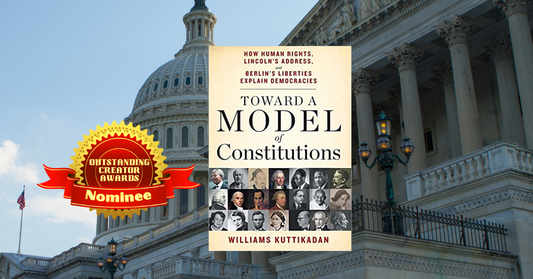|
Score: 95/100 (9.5 out of 10)
Toward a Model of Constitutions by Williams Kuttikadan is a remarkable achievement in the realm of political science and philosophy. It is an invaluable, well-research educational work in that discipline. Although the book is based on the US Constitution, it has implications for all constitutions—past, present, and future—throughout the world. The greatest accomplishment of this book, beside the general presentation of valuable information, is that it presents information in an unbiased and matter-of-fact way, apparently without motive (by the author). This is very impressive and admirable as it can be frustrating when an author/educator's bias is apparent and taints the presentation of that information. We experienced that in the past with Rise from the Blue by Boade Mandeng (a clearly right-wing-leaning work) and Wisdom by Jason Merchey (a clearly left-wing-leaning work). That's not the case here, at least from what we could tell. We haven't seen a more unbiased, matter-of-fact presentation of political information since we read Trust and Confidence by Jim Lichtman in December 2021. It has been a while! However, this is both the book's greatest strength and one of its greatest weaknesses. It's a double-edged sword, in a sense. It seems to be... missing something. It seems to be missing any sense of pep or energy. That's not to say that it didn't take a ton of passion to research, write, and edit this book, but that passion isn't evident in the dry presentation of this information. It is, in fact, very dry and maybe a bit dull. However, if you've ever read a textbook about legal process, this is par for the course. Legal textbooks aren't usually melodramatic stage-plays or epics created for your entertainment, they are informative, educational texts created to let you know what's up. This book is clearly intended as such a text. It's incredibly informative and educational, looking at various aspects of politics from the top to the bottom—everything from rule of law, checks and balances, vote share, levels of government, stages in the evolution of government, organizational spaces, the liberty space, models of self-control, self-regulation, natural resources, and monetary system (along with the taxes that naturally come with them). To say that we learned a lot of things we didn't know (or even didn't know we wanted to know) would be an understatement. There is so much incredible information packed into less than 300 well-formatted, sharply-written pages. There are even helpful diagrams and charts accompanied by a truckload of sources that demonstrate the enormous amount of research that went into this. And the sources are legitimate, not just links to some opinion piece or Wikipedia. That is also impressive. How could this almost-perfect educational book have been better? What was it missing? Well, we think we figured out the answer to that question. It was missing stories. Think about it. Yes, it's important to explain the constitution, the laws, the ins and the outs, but you should also provide examples. It's one thing to say, “Taxes are necessary for rule of law” or “governments shouldn't interfere in the private space” but... can you provide specific examples of why that is? If this were an essay, wouldn't you—the educator—expect the same from your students? If this were a scientific research paper, wouldn't you need to provide specific details that prove your conclusions? The author seems to present a really idealistic way of how things work. Anyone who has written and tried to carry out a plan knows one thing: things aren't going to go to plan. That's why we have the checks and balances the author describes, especially the judicial system which interprets laws. The very fact that we have a branch to interpret laws shows that the system is not so ideal or so perfect. And we're not saying that's what the author says, but that's how it feels. We love the US Constitution and agree with over 95% of what the author says. At the same time, we would've loved a little more flavor to this text. For example, in WINX by Irma Parone, the author provided multiple different examples (real-life stories) of times when business owners and companies made terrible or even dangerous decisions. If the author were to explain different concepts like the amendments, shouldn't there be examples of these amendments in practice? Like, how about when explaining the first amendment Now, in all fairness, there are references to how different concepts affect the governments of different parts of the world like North Korea and Sub-Saharan Africa. However, even that is mentioned but not delved into. But we digress because there's so much GOOD in this book. Our favorite part of the book concerns the three theoretical frameworks that explain the concept of liberty: Mandela's freedoms, Berlin's liberties, and improvement-perspective. The author is not afraid to point out potential errors in reasoning or practice, particularly in Berlin's liberties, as these ideas were all cultured at times that were different from our own. Mandela's freedoms almost seem to form the “heart” of the book as they are often referenced and seem to form the “ideal” from the mind of one of the great visionaries and leaders of our age. Really, check out this book and consider putting it on your syllabus if you teach social or political sciences at the college level. Check it out on Amazon!
0 Comments
Leave a Reply. |
Archives
July 2024
Categories |

 RSS Feed
RSS Feed